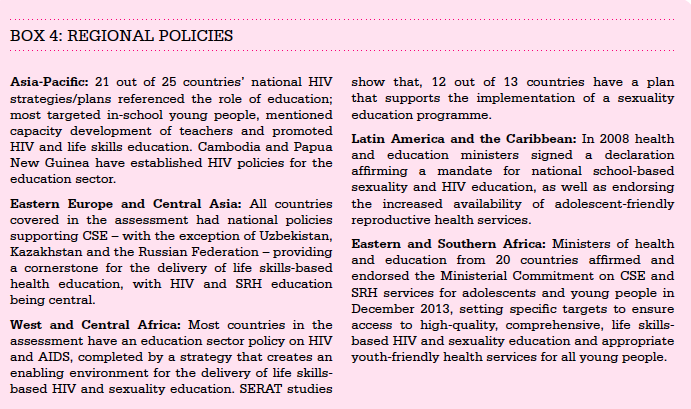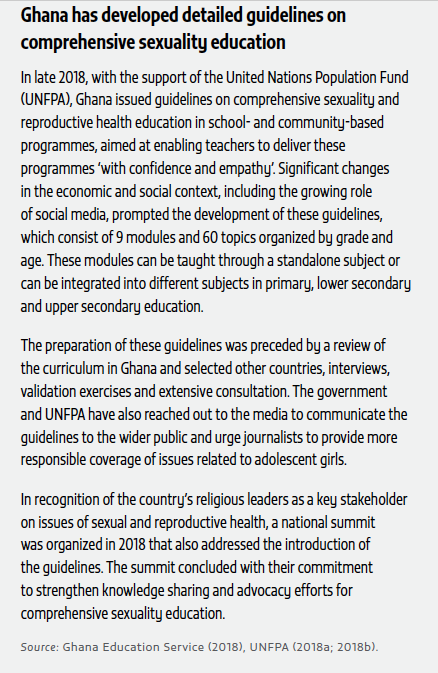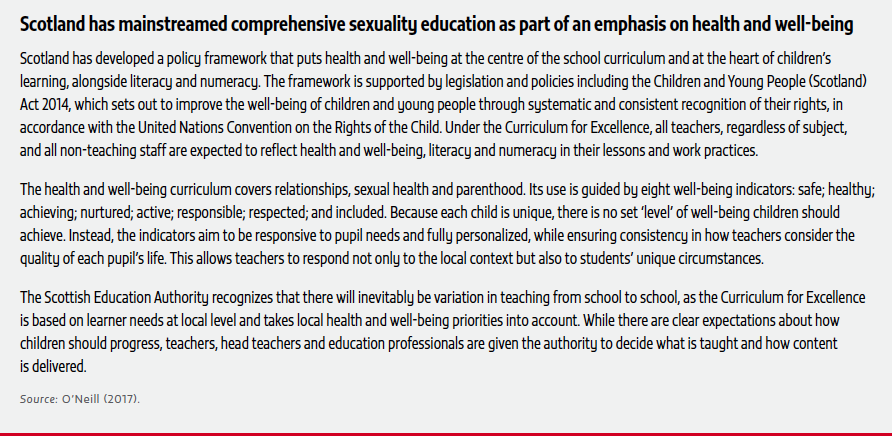Education is UNESCO’s top priority because it is a basic human right and the foundation on which to build peace and drive sustainable development. UNESCO is the United Nations’ specialized agency for education and the Education Sector provides global and regional leadership in education, strengthens national education systems and responds to contemporary global challenges through education with a special focus on gender equality.
The specific role UNESCO plays in supporting CSE implementation worldwide is described in HIV and Sexuality Education.
The ways in which UNESCO’s work on CSE supports the more expansive work of fulfilling the SDGs is described in UNESCO Strategy on Education for Health and Well-Being: Contributing to the Sustainable Development Goals.
Understanding the Context for CSE Globally and Locally
An enabling legal and policy environment is critical to the promotion of sexual health. Although there is significant work remaining to ensure that the content and delivery of CSE benefits all young people, there is increasing political commitment to providing CSE worldwide. A majority of countries are now embracing the research and recommendations demonstrating the effectiveness of CSE, and seeking to strengthen its implementation at a national level. (IPPF, 2017, p. 47-48)
Countries have committed at the level of the United Nations General Assembly “to accelerate
efforts to scale up scientifically accurate, age-appropriate, comprehensive education, relevant to cultural contexts, that provides adolescent girls and boys and young women and men, in and out of school… with information on sexual and reproductive health and HIV prevention, gender equality and women’s empowerment, human rights, physical, psychological and pubertal development and power in relationships between women and men, to enable them to build self-esteem, informed decision-making, communication and risk reduction skills and develop respectful relationships” (United Nations, 2016).
Different regions have shown leadership in the development and implementation of CSE, from demonstrating increased political will, to developing and investing in CSE programming.
-
Western Europe pioneered the introduction of school-based sexuality education programmes 50 years ago. Countries such as Sweden, Norway and the Netherlands, with long-standing sexuality education programmes in schools, have significantly lower adolescent birth rates than countries in Eastern Europe and Central Asia (EECA), where open discussion of issues related to sexuality and sexual and reproductive health and rights (SRHR) in schools remains more sensitive.
-
Within Europe, the WHO Regional Office produced Standards for Sexuality Education in Europe, which provides a framework to support policy-makers, education and health authorities, and other stakeholders, in implementing quality standards for sexuality education across the region.
-
The Ministerial Commitment on CSE and sexual and reproductive health services for adolescents and young people in Eastern and Southern Africa (ESA) has been endorsed by 21 countries in the Eastern and Southern Africa Region.
-
In Latin America and the Caribbean, ministers of health and education declared their commitment to sexuality education through the Preventing through Education Declaration signed in 2008. Governments committed to integrating strategies and ensuring interdepartmental coordination and agreed to implement and strengthen ‘multi-sectoral strategies of comprehensive sexuality education and promotion of sexual health, including HIV/STI prevention’ (UNAIDS, 2009).
-
Countries including Argentina, Uruguay, Colombia, the Dominican Republic, Cuba, Peru and Mexico have also developed policies or national legislative frameworks, making the delivery of CSE compulsory. More information on CSE in Latin America and the Caribbean is described in the report, Políticas Educativas, Jóvenes Y Sexualidades En América Latina Y El Caribe: Las Luchas Feministas En La Construcción De La Agenda Pública Sobre Educación Sexual.
-
The Asia-Pacific region has traditionally had a highly favourable policy environment towards implementing HIV education, with most countries integrating broader sexuality education into national HIV strategies (UNESCO, 2012a). The commitment from the Asian and Pacific Population and Development Conference in 2013 focused on ensuring SRHR for all, particularly the poorest and most marginalized populations and recognized the need for sufficient resources for sexuality education programmes.

Existing normative frameworks, policy and legal environments supportive of CSE
There are several international agreements, instruments and standards related to CSE, including:
-
The 2030 Agenda for Sustainable Development
-
Education 2030 Incheon Declaration and Framework for Action for the implementation of Sustainable Development Goal 4
-
Political Declaration on HIV and AIDS 2016: On the Fast Track to Accelerating the Fight against HIV and to Ending the AIDS Epidemic by 2030
-
Human Rights Instruments, Covenants and Standards:
-
The Universal Declaration of Human Rights (1948)
-
Convention on the Elimination of All forms of Discrimination against Women (CEDAW 1979)
-
Convention on the Rights of the Child (1989/90)
-
International Covenant on Economic, Social and Cultural Rights (1966/76)
-
The Convention on the Rights of Persons with disabilities (2006)
-
-
Beijing Declaration and Platform for Action, the Fourth World Conference on Women, 1995
-
International Conference on Population and Development (ICPD) Programme of Action (PoA)
For details on what each of these instruments says about CSE, refer to Appendix 1 of the ITGSE 2018.
Status of CSE implementation at the regional and country levels



(Source: UNESCO, 2015 – Emerging evidence, lessons and practice in comprehensive sexuality education: a global review)
Language used to describe CSE programmes and communicate key concepts and relevant terminology on SRHR
CSE may go by other names depending on the country or region. It may be referred to as “life skills,” “family life,” or “HIV” education. It is sometimes called “holistic sexuality education.” It is important to confirm with ministries what they use to describe CSE, particularly as more conservative or euphemistic terms can inform the most effective approach to take when partnering with and supporting these ministries.
